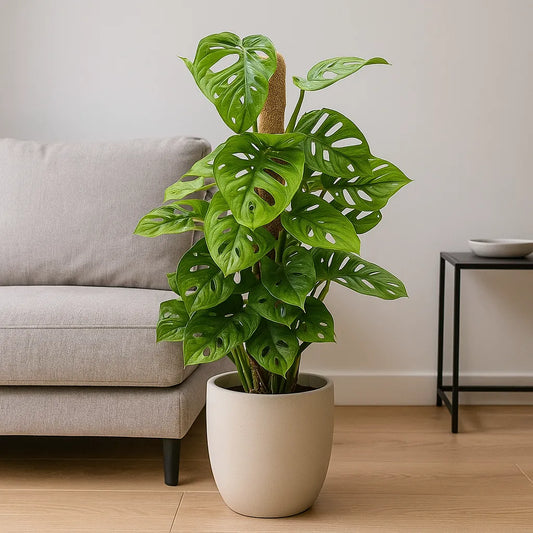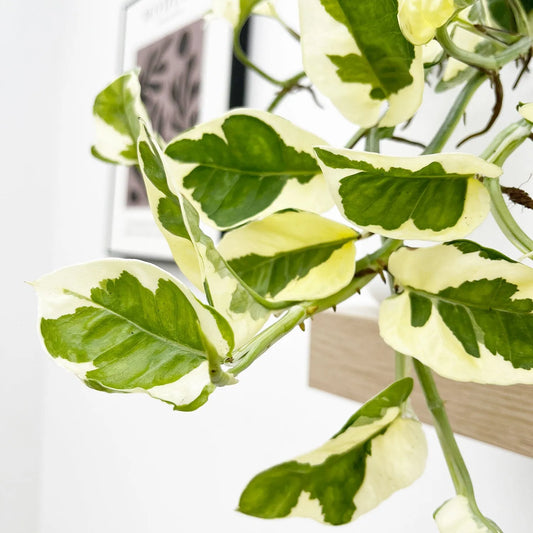A guide to Ficus Elastica Propagation
The Ficus Elastica or ‘rubber tree’ is one of the most popular houseplants in the UK, they are easy to grow, simple to look after houseplants that brighten and liven any space. Propagating a Ficus Elastica is easy, and a great way to introduce yourself to plant propagation so you can fill your home with these wonderful plants or give them to friends as gifts. In this guide we will take you through everything you need to properly make and root Ficus Elastica cuttings.
What is plant propagation?
Plant propagation is the process of creating new plants by taking cuttings of an existing plant and growing a new plant from it. The new plant will be genetically identical to the ‘mother plant’ and is a simple and easy way to multiply plants that are disease resistant or that have features you like.
How easy is the Ficus Elastica to propagate?
The Ficus Elastica is an easy to grow houseplant that can deal with a lot of stress and changes. In the wild this tropical houseplant has been known to grow up to 100 meters tall. In the home the Ficus doesn’t grow as tall, and it’s fast growth means you will find yourself pruning it more often. It is these parts of the plant that you prune that can be used to grow brand new Ficus plants. Every time you cut the plant it encourages new growth to form from the area that is cut, this is true for the mother plant, but if you treat the cutting in the right way you can end up producing a whole new plant.
What do I need to make Ficus Elastica cuttings?
Whilst the Ficus Elastica is an easy to propagate plant you will need some tools and equipment before you get started.
Gloves - the sap of the Ficus Elastica is mildly toxic to humans if it is ingested or makes direct contact with the skin. You should wear gloves when pruning or cutting your Ficus Elastica to protect yourself.
Sharp pruning shears or scissors - The key to getting good quality cuttings of your Ficus Elastica is to make clean cuts to your plant. If the cut is not straight you may find that it takes longer for more growth tpo start or the cut may just heal over.
Perlite - perlite is an important part of plant propagation. It helps to aerate and loosen the soil which allows the young, delicate roots of your cutting to form.
Rooting hormone - rooting hormones increase the chance of your cuttings taking root and growing quicker. These hormones are found naturally in plants, but will be in much lower quantities in cuttings. By adding them to your cutting’s planting medium you help increase the speed of growth and health of your new plant.
Soilless potting mix - young plants, especially those that come from cuttings are susceptible to fungal and bacterial diseases that can be contracted from soil. It is best practice to use a soilless potting mix when propagating any plant, especially more difficult ones. Generally a soil mix will contain a mixture of perlite, vermiculite, coarse sand and peat moss.
Small plastic pot - you will need small pots to germinate your cuttings in. These pots will only be temporary until your cutting is big enough to be repotted. Seedling pots are ideal for germinating new plants.
Plastic zip-lock bag - A zip-lock bag is needed to provide humidity and warmth to your cutting. It works in the same way as a greenhouse of propagation tray.
Paper towels - fresh Ficus Elastica cuttings will produce a lot of sap. Make sure you have a lot of paper towels ready to clean up any mess.
How to propagate your Ficus Elastica?
Prepare to take your cuttings
Propagating Ficus Elastica is easy, but it can be a messy task since they contain a lot of thick sap. You will need to protect yourself and your work surface before you start. It also highly recommended that you clear your workspace completely of anything you don’t need before starting so you can work quickly and cleanly.
Choose where you will be taking your cuttings
When taking cuttings of your Ficus Elastica you should always choose the spot where you want to take your cuttings first. Remember that the space you take your cuttings from will likely produce a lot of new growth so look for parts of the plant that are uneven or spots where you would like fuller growth.
When you make and plant cuttings you need to identify the correct areas to cut. Rubber tree cuttings should be about six inches long and have at least four leaf nodes for the best results. Make sure you can find a space on your plant that meets these requirements.
What is a leaf node - Nodes are a part of a plant where leaves and stems connect to other parts of the plant. A leaf node is the small bump at the base of a leaf stem where it meets the main part of the plant. When you make your cutting you will cut the stem above and under these nodes so you have a piece of stem with leaves attatched.
Make your cuts
Once you have chosen where you are making your cuts, take your shears or scissors and make a quick, clean cut directly above a leaf node and about an inch below it. You should end up with an inch of stem with about four leaves attached.
It is likely that your cutting will be dripping sap when first cut, if it does use a paper towel on the affected area until it stops.
Prepare your cuttings for planting
Once the cuttings have been taken, remove the smaller leaves to ensure that the plant redirects its energy to creating new roots rather than growing the leaves. If you live in a low-humidity area you may get some benefit from rolling the leaves so that the waxy side is on the outside and securing it with an elastic band. This will help to maintain moisture
Plant the cuttings
Fill your plastic pots with your soilless potting mix and perlite and water thoroughly. Take your cutting, and apply some rooting hormone to the end. Poke a small hole into the potting medium and push the cutting in until the lowest node sits on the surface. You may need to support the cutting with a small stake. Pat the soil down to secure the cutting in place. Place the zip-lock bag over the cutting to create a greenhouse-like effect. Ficus elastica cuttings require humid environments to properly sprout roots.
Leave to grow
Place your cutting in a warm location that receives bright, dappled sun throughout the day. Avoid direct sunlight as it might damage the young leaves. Water the soil regularly to keep it moist and mist the young cuttings regularly to keep the leaves moist.
Your Ficus Elastica cuttings will take about four to five weeks to begin establishing roots. You will know that they are ready to repot when you can gently lift the plant in the soil and feel resistance.
Can Ficus Elastica be propagated in water?
Ficus Elastica cuttings can be propagest in water, but it is a lot less effective than the above method. To do this, follow the steps above, but instead of planting in a soilless potting medium, put the cutting in a cup or bottle of water that has had some fertilizer added. It will take five to six months for a water propagated Ficus Elastica to properly develop roots. You will need to change the water weekly and make sure it doesn’t become stale.











Leave a comment
Please note, comments need to be approved before they are published.